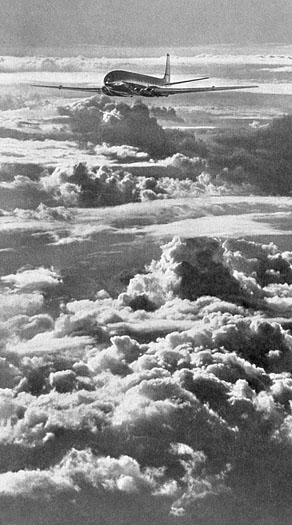Comet Concept
Flying quickly and efficiently implied travelling in thin air at high altitude; a perfect application for gas-turbine engines. In April 1942, de Havilland became Britain’s second jet engine manufacturer with the successful test of the Goblin engine. They also built wind tunnels to measure “compress-ibility”: an aerodynamic property that acted like a barrier to anything approaching the speed of sound. Research concentrated on swept wings, which raised the speed at which compression effects occurred. In June 1943, de Havilland put forward a radical concept for the Type IV with three jet engines, a tail-less, swept-wing shape, and room for six passengers.
De Havilland had to fight a strong case for jet propulsion rather than propellors with the Ministry. In September 1943, they began trials of their new jet fighter, the DH-100 Vampire. Pilots remarked that its quietness and lack of vibration was ideal for passenger service.
Britain's national airline, the British Overseas Airways Corporation (BOAC) were strongly in favour of jet-power, too. They argued that a jet airliner would be more expensive to buy and use more fuel, but it would fly faster and require less frequent maintenance, resulting in more useful time in the air. Speed was the key: if the aircraft could do 500 mph, it would pay for the investment in technology.
In 1944, de Havilland began developing a more powerful jet engine, called the Ghost. By February 1945, a revised proposal was made with four Ghost engines under the trailing edges of the wings (like Concorde), an all-up-weight of 75,000 lbs and room for 24 passengers. Its 40º swept wing gave it a theoretical speed of 600 mph.
A half-scale prototype was commissioned for![]()

